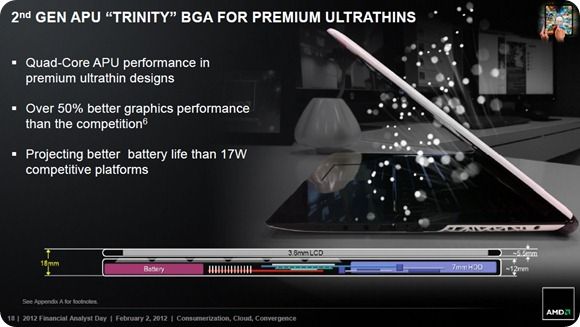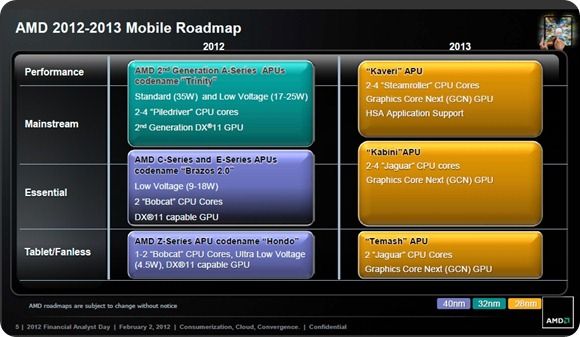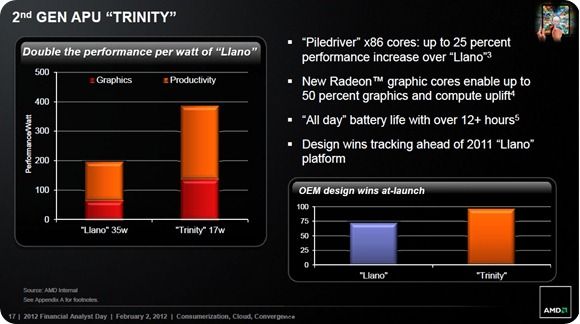At the AMD financial analysis day a few days ago (FAD) three families of APUs targeting the sub 20W TDP space were announced which means good options and good competition in the mobile computing space and with the low-power ‘Trinity’ application processor unit (APU) an interesting (competitor for Intel + products for us) addition to the thin-and-light market. It’s exciting news and something we’ll be following, and eventually testing, on Ultrabooknews. Here’s my analysis of the facts presented. We’ll be ignoring the AMD C, E and Z series APUS in this article. They are targeted at tablets and low-cost netbook-style devices.
The question here is – What does ‘Trinity’ A-series enable and will it be a true Ultrabook competitor?
From AMD’s Fusion blog:
New for 2012, AMD will introduce a low voltage “Trinity” APU that will be ideal for the next-generation of ultrathin notebook. This “Trinity” APU matches the experience enabled by the AMD 2011 APU in up to half the TDP. As we said, “Trinity” is on track for introduction in mid-2012.
Trinity is the codename for an APU platform based on ‘Piledriver’ CPU cores. There will be an ‘A6 series’ 17W TDP version that will be interesting for the Ultrabook market and AMD is saying that it will offer the same performance as the current ‘Llano’ APUs at 35W. What does that mean?
Clearly the A6 (Trinity ULV 17W TDP part) will have 2 Piledriver cores.
It means AMD will use a CPU core that has “25% performance increase over Llano” to create a (probably lower-clocked on average) 17W TDP version of the platform. The A6 will also have a GPU that performs 2x faster than the current Sandy Bridge solution – possibly beating the Ivy Bridge HD 4000 GPU solution.
Turbo wars
If you compare the claims with current A8 3500M which is a 35W TDP 1.5-2.2Ghz Llano mobile APU introduced for laptops in 2011 you can see the sort of performance levels AMD are talking about. It’s Ultrabook levels of raw CPU power and a big advantage in GPU power. The big variable is turbo boost. Can AMD hold the turbo for as long as Ivy Bridge can. Sure, the TDP might be 17W now, but at what cost in Turbo?
There’s huge scope for creative marketing when it comes to stats that include the use of thermally limited turbo boost. While a 30 second test may hold the max clockrate, what happens during a 2 minute video render when the system heats up and turbo-boost is unable to operate?
Tricky GPU benchmarking?
As far as the GPU is concerned, here’s a quote from the notes on the slides presented at he AMD analysts day. “Results show 3D Mark Vantage for the A6 ULV 17W “Trinity“ to score 2355 3D marks.” Ultrabooks are scoring about 1500-1600 on 3D Mark Vantage although AMD used a lower-clocked Core i5 (that doesn’t actually appear on Ultrabooks) and measured 1158 in their tests. Given the low test scores AMD’s asssumption that Ivy Bridge will improve by 30% and the early benchmarks for Ivy Bridge showing a 50% improvement, there may not be a great difference come Q3. Again, it will depend on how good turbo and thermal designs are at keeping clock rates high.
Price – Lower cost products won’t be Ultrabooks
AMD are talking about “sub $900” pricing which, if that covers an average price point, is likely to beat Intel-based Ultrabooks. It’s no surprise that AMD will try to compete on price though and given that manufacturers will be looking to extend their product lines with cheaper options that look like Ultrabooks, products are likely to follow the low-cost lead by using lower-quality components inside cheaper designs thus leading to significantly cheaper, but difficult to compare products. Note: If existing Ultrabook designs depend on Intel IP (thermal designs for example, are likely to have been patented) then we are unlikely to see AMD versions of existing Ultrabook designs. These cheaper solutions will definitely find a strong place in the market but they are unlikely to be directly comparable to Ultrabooks. (See below for a list of Ultrabook experience elements.)
‘FAD’ Slides are available here.
Battery life marketing – Ignore
As for battery life, AMD says that battery life will be “over 12+ hours.” Looking at the accompanying slide notes shows us this is an idle figure for a 35W TDP test system. Ignore that! On the 17W TDP ‘ultrathin’ part AMD says they are “projecting better battery life than 17W competitive platforms.” Two things spring out of this statement. Firstly, ‘projected’ means they aren’t sure because it depends on their customer designs. In normal use, a CPU/GPU only accounts for 30% of the battery life of an ultrathin too. Given that there are no projected weight figures for an AMD ultrabook, one can also see AMD encouraging bigger batteries and slightly heavier devices. Secondly ‘competitive platforms could mean ones based on Sandy Bridge that have additional GPU power. i.e. the Samsung Series 5 14” with discreet AMD graphics. There’s so much uncertainty in the battery life statement given by AMD that it’s unlikely to be a key feature of AMD A6-based ultrathins.
Availability: Mid 2012
Summary:
We suspect AMD will have a competitive platform in Trinity A6-series APUs although CPU and GPU performance advantages may reduce to less than zero when we start comparing Ivy Bridge-based devices and include efficiency. A lot of the performance information depends on missing turbo boost figures which, in turn, depend on thermal design and advanced cooling systems. AMD will be relying on their customers here.
If AMDs customers do manage to make some great designs (we expect updated HP DM1 and Lenovo S205 designs getting Trinity A6 APUs and being very competitive on price) then yes, AMD are in the game and will create competition and a good range of products. These products may not be directly comparable to Ultrabooks though. Consider these Ultrabook experience elements that are becoming core parts of the Ultrabook and have nothing to do with CPU or 3D performance.
- SSDs (will they be in ‘sub $900’ ultrathins?)
- Security subsystems available in Ultrabooks
- Thunderbolt ecosystem
- Intel’s Smart Response bios/controller and software solution for hybrid storage solutions
- Wireless Display ecosystem
- Patented thermal designs (E.g. keyboards as air intakes)
- Panel Self Refresh technology
- Video encode hardware (or GPU assistance)
AMDs ultrathin strategy and the Trinity A6 APU is great news for the lightweight laptop market. For those who are looking for a no-frills ultralight with great CPU and GPU performance for the price, there are likely to be some excellent solutions in Q4 but be careful how you compare them to Ultrabooks.














Do Intel ULV’s TurboBoost? If not, I don’t see the relevance if AMD does or doesn’t.
Core i5 and i7 have turbo boost. Up to 2.7Ghz on the core i7. Will go up to 3.0Ghz on the best Ivy Bridge ULV chips. This is why turbo boost is so important. ‘How long can it sustain turbo boost’ is the big unknown for all benchmarks.
Intel calls it “Tubo Boost”, which like Chippy stated is available for the Core i5 and i7, and AMD calls it “Turbo Core” and they seem to be applying it to most of their newer chips.
There are also other factors like how AMD’s Turbo Core works with dual cores is to over clock one core while under-clocking the other. So really only benefits single core processes.
Both technologies also rely on predictive demand, meaning the system has to accurately predict when the boost is needed.
First gen Intel Turbo Boost didn’t predict so well and some users even turned the feature off because of that but 2nd gen version seems to work pretty well now.
While AMD’s Turbo Core is up to 2.0 but still has to prove itself. Though because of the embedded GPU it does mean a fairly consistent boost to graphical performance.
Next gen systems may also employ other enhancements like higher performance mode when plugged into AC. So the 17W or less TDP would be just for mobile use and system can provide even more performance when plugged in.
I think you may be confused. The Turbo Mode on the Core chips worked pretty well, it was the previous generation Dynamic Acceleration that didn’t really work.
That was the sole reason for the mobile chips being significantly faster than predecessors, especially the 18W parts.
Even now with TurboCore 2.0, its behind the first generation Turbo Mode. http://www.anandtech.com/show/5058/amds-opteron-interlagos-6200/9
Phenom II X6 Turbo: Didn’t work in lot of applications, and there was no full core Turbo
Llano: Full core Turbo is minimal
Bulldozer: High full core Turbo but can incur significant performance penalty in some cases
What are the chances this APU making its way to a 10″ notebook with fairly thin bezels? Maybe 1″ inch “thin” since (to me) any thinner than that starts going into the diminishing returns category.
Very low, still generates too much heat, but can probably make it into a 11.6″ size system.
I wouldn’t call it impossible. Panasonic manages to fit a Standard Voltage Core i7 in the J10.
It’s not likely though. 10 inch isn’t that popular of a form factor for anything other than Atom based netbooks.
Popularity isn’t a problem but the Panasonic 10″ systems are very pricey and very thick, small and thin combination is the problem.
If there is no demand, there is no supply. Any 10 inch notebook with anything more powerful than an Atom tends to be a niche product it seems.
The J10 is over an inch thick, but it weighs significantly less than any ultrabook despite this. sub 1kg w/ smaller battery and no protective jacket. It’s not sexy, but it definitely is still very portable.
Again, the Panasonic J10 is also more pricey than a Ultrabook and not just thicker.
More compact systems are not new but they do come at either a performance and/or price premium.
While if there was no demand then there would be no 10″ models at all! Neither Intel or MS ever liked the netbook market because they made very little profit and it helped force MS to offer lower priced versions of Windows.
Even tablets are partly pushed by the demand for more portable solutions.
So the problem isn’t demand, but just not a willingness to pay a premium for the size range.
Btw, the J10 weighs 1.2KG and is not sub 1KG. While the battery only looks small but you’re not going to get 7.5 to 12 hours from a smaller battery on a Core i5 or i7 system.
If they managed that, I’d buy it for sure.
AMD Turbo is limited by TDP, unlike Intel’s which is temperature based and can go over TDP. I wouldn’t worry about Trinity not being able to sustain turbo, but rather whether it can turbo high enough to compete with Intel chips that are able to go over 17 watts if cooling permits.
Also, Bulldozer turbo works on all cores unlike Phenom II turbo. I would look for hints at what Trinity’s turbo will act like in Interlagos server chips rather than Llano since Llano is Phenom II based and Bulldozer represents the first complete ground up redesign that AMD has had since K8.
Well they are moving to Turbo Core 3.0 but it remains to be seen if that’ll be a big improvement from 2.0 or not.
Useful tips. Thanks!
Sandy Bridge chips have two Turbo frequency modes, Short and Long.
The Long duration Turbo is the sustained, TDP Turbo. The short is the short-term boost that goes over TDP.
The 1.8GHz 2667M 17W Core i7 can do 2.4GHz Long duration, and 2.5GHz Short duration while two cores are running.
I was partly confused, as I was thinking of some of the lesser examples and as you probably know benchmarks aren’t always reflective of real world performance and both Intel’s and AMD’s boost methods do rely on correctly predicting when the system needs the boost and when it needs to maximize power savings.
So it’s both whether it provides a actual performance boost and whether it comes at a too high power consumption hit or not.
Mind AMD is applying the Turbo Core feature to their low end AMD Fusion chips with the C-60 and E-450, which are limited to only over clocking a single core while under clocking the other. Along with a smaller boost in clock speed.
Anand showed benefit with the higher end multi-core solutions, but as the AMD Fusion chips show that doesn’t necessarily reflect the entire range and fewer cores gives fewer flexibility of operating mode options.
While we don’t have that large a sampling of real world usage to compare. So AMD Turbo Core isn’t as fully vetted as Intel’s Turbo Boost and though 2.0 may have finally made Turbo Core a real positve boost.
It just remains to be seen whether 3.0 is a significant improvement compared to what Intel’s next gen is offering, but it at least shows AMD is doing its best to keep up with the latest advancements.
Both AMD and Intel are coming out with features like Configurable TDP, which should prove beneficial to the Ultrabook market.
@James “whether it comes at a too high power consumption hit or not” is another good point.
Turbo boost that effectively lets the power consumption rise too high, could be bad.
HUGI (area under the curve) is the most important measurement. Unfortunately, no-one is measuring that.
Power management has been something Intel was always ahead of AMD. They were the first to implement catastrophic thermal protection, the AMD chips didn’t have them hence the videos of the chip burning up. By the time AMD got to putting that in, Pentium 4 generations got much more advanced protection, where it throttles before it shuts down.
The early Phenoms had a problem where power management had to be turned off, to avoid big performance loss. It seems even Bulldozer with TurboCore 2.0 has similar, though more intermittent issue.
They’ve caught mostly up to Nehalem’s Turbo using TurboCore 2.0, but they seem to be missing something every time they “catch” up to the last generation parts. The first Turbo Mode might not have been able to sustain the performance as well as the version 2.0 had, but it was stable enough to almost calculate what frequency it was running at.
Also the thing about Configurable TDP. For Ivy Bridge, its on mobile chips, while for AMD its on server chips. Actually Intel does have power cap feature on Westmere, but on a platform level instead. Trinity has 17W, 25W, and 35W offering so it doesn’t have one, probably in the next generation.
Not always though, and that video of a AMD chip burning is close to 10 years old, and it was obviously fraud as they also show the Intel chip not crashing with no cooler, would AMD chips burn? Yes they would, but even back then the idea of a cooler falling off was ridicoulus, and although slow to react, the system that was in most motherboards at the time wouldn’t fail to turn off if the fan stopped moving, in other words a AMD CPU burning almost never ever happened, and I’ve had AMD for over 10 years.
AMD was the first company to introduce power management to Desktops, it shouldn’t be a surprise that Intel has the resources to implement it better in shorter time, but really I haven’t seen any issues with Turbo or power management on Bulldozer, and from what I see TurboCore 3.0 will definitely be competitive to what Intel has, if it works as they show, it will put AMD chips even further ahead of Intel chips in term of “user experience” which is already good on current AMD chips, thanks to the more balanced approach of the APU.
You’re right about the configurable TDP, although I’m not sure we’ll see AMD implement it as I don’t see the demand for it, but if they did it wouldn’t be hard, you can already configure Llano APU’s using K10Stat, so it shouldn’t be hard for AMD to make software that does it better if there was any real demand.